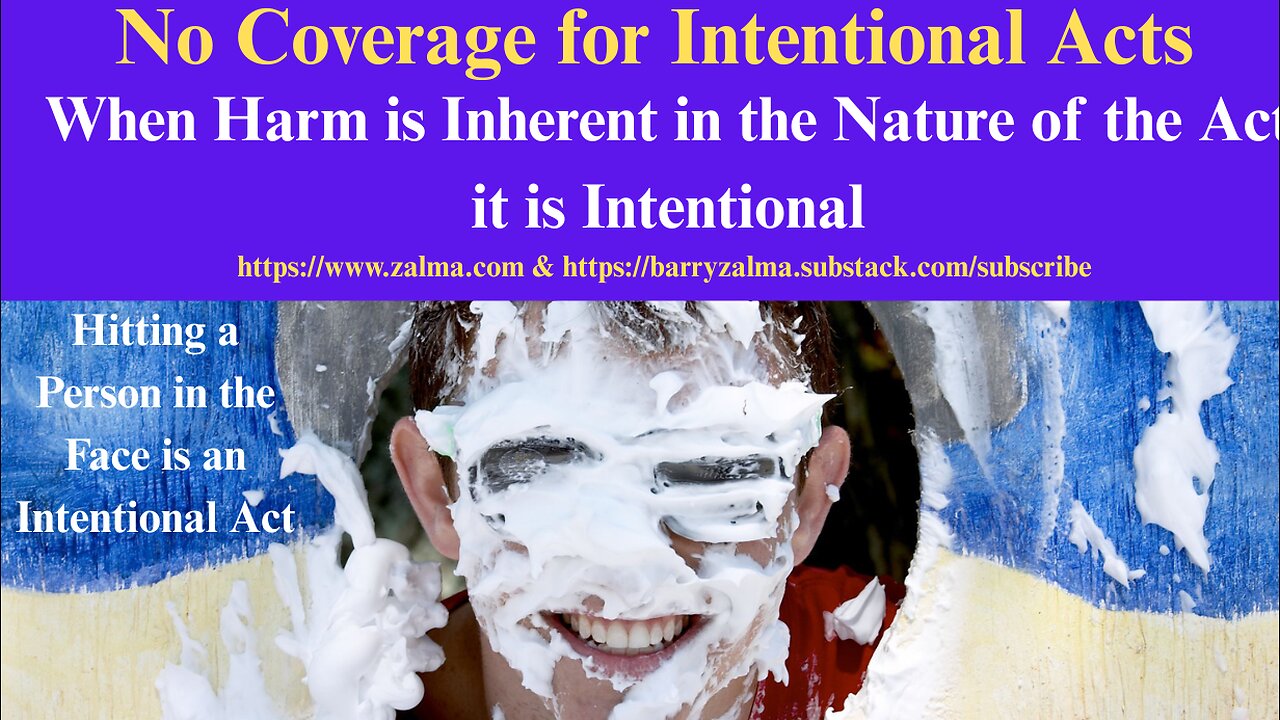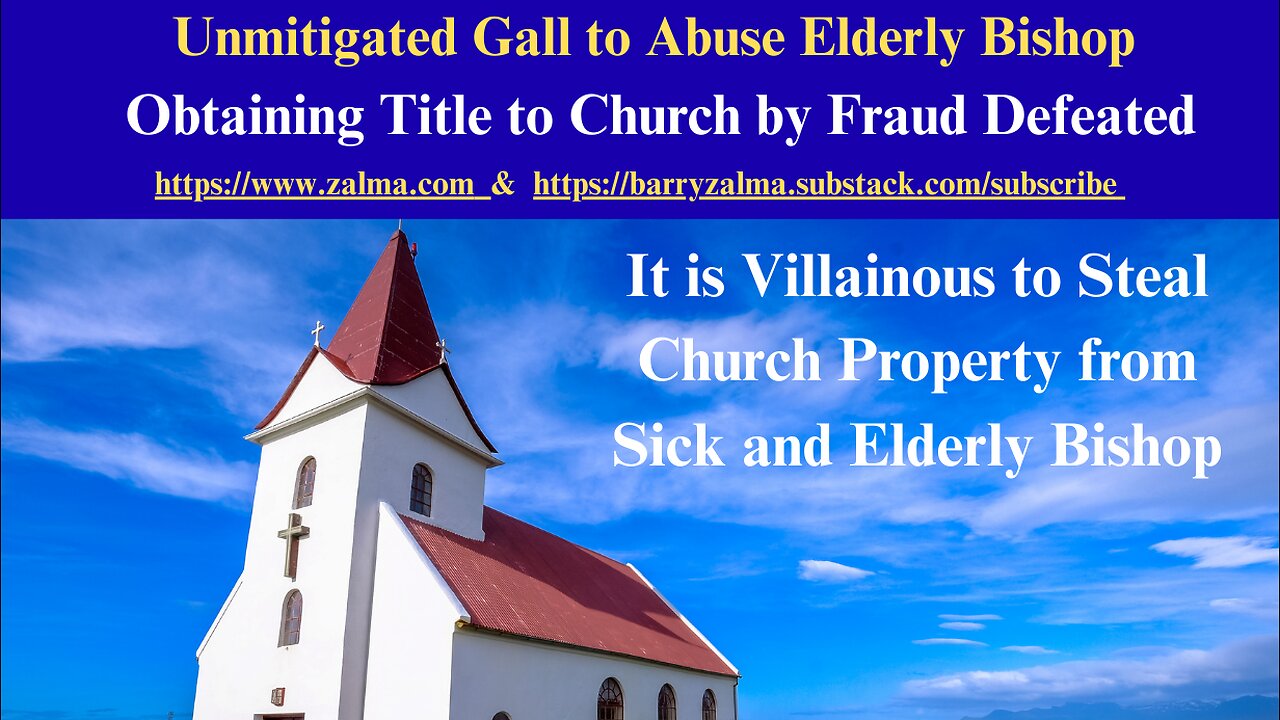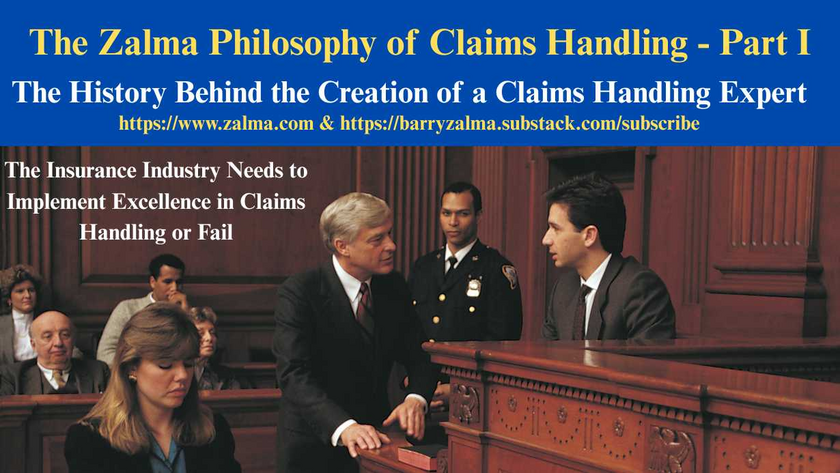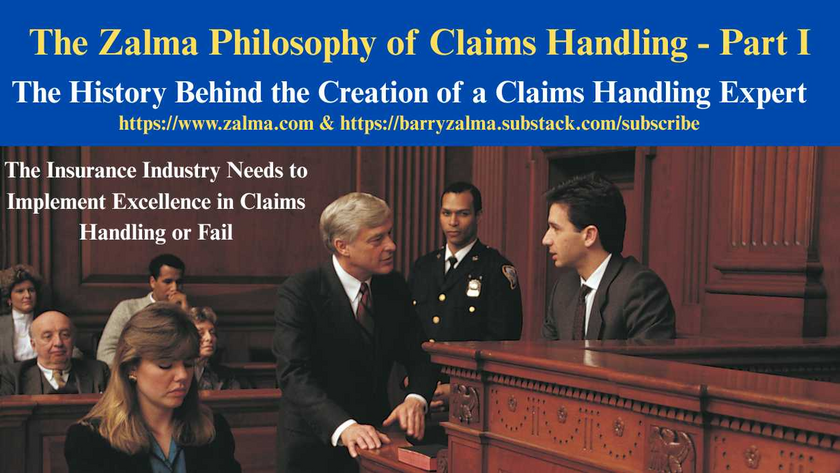
How to Put Fear of Insolvency Into a Defendant
Barry Zalma
Jan 31, 2024
Read the full article at https://lnkd.in/gMtYw3Ef, see the full video at https://lnkd.in/gyRWwS7S and at https://lnkd.in/g4YGzgg6 and at https://zalma.com/blog plus more than 4700 posts.
Post 4725
For more than fifty six years working in and about the insurance industry I For more than fifty six years working in and about the insurance industry I have personally seen the fear in the faces of corporate executives faced with a suit claiming wrongful conduct and punitive damages. Even those who knew that they had acted properly and fairly and that the allegations of the suit were totally spurious, the fear and trembling engendered by a suit seeking punitive damages is patent.
The defendant who should be leading a charge like General Patton acts more like Prime Minister Neville Chamberlain. Defendants seem to prefer to appease a plaintiff rather than litigate good and viable defenses. Unless counsel advises a 100% chance of total victory – a statement no trial lawyer will ever make – the defendant does not want to go to trial and is willing to pay more than it owes to avoid the potential of a serious punitive damage judgment.
Contrary to common belief the chances of a suit seeking punitive damages actually obtaining an award of punitive damages is very small.
Defendants often, incorrectly, concentrate on trial verdicts and overlook that almost all civil litigation matters result in out-of-court settlements. Verdicts are important but punitive damage verdicts are more like the tip of the proverbial iceberg than evidence of a trend. Practical evidence indicates that the small number of trials affect decisions in the vast majority of lawsuits that do not proceed to trial.
Verdicts are taken as important signals to the litigants. It is important to first understand the basic dynamics of a lawsuit. Most of the work in pre-trial litigation is designed to provide the litigants with enough information to allow them to reach an amicable settlement. A large punitive damages verdict skews the evidence available to the litigants and causes plaintiffs to demand more than their cases are truly worth and defendants to pay more than they should to resolve a suit seeking punitive damages.
Under basic American litigation practice the plaintiff has the opening strategic advantage. A plaintiff with a weak case places the defendant in the position of having to defend himself (and therefore incurring legal costs), or else the defendant will be liable for the full claim on a default judgment. Even a defendant facing a suit that has no merit and no chance of success before a court will often be willing to pay an amount that is less than his prospective defense costs to settle the case and “make it go away.” Appeasement of the plaintiff is, to a corporate defendant, seen to be economically the best solution.
According to various studies, the cost of defense in an average tort lawsuit ranges from $6000 to $10,000, depending on the kind of suit. A litigant with even a mildly plausible basis for an average suit can often expect a nuisance settlement value within this range.
Most often a defendant is willing to pay a settlement up to the amount of his defense costs in order to avoid having to respond to the plaintiff’s complaint.
The main determining factor of whether a filed lawsuit will yield a settlement to the plaintiff is the credibility of the threat made by the suit. The defendant and counsel determines the probability of a verdict favorable to the plaintiff if the case goes to trial. If the probability is that the plaintiff will succeed the defendant then analyzes the likely amount of damages that the plaintiff could obtain from a trier of fact in the jurisdiction where the suit is filed.
In frivolous or marginal lawsuits, or lawsuits with a doubtful chance of success at a trial, settlements often occur because the defendant rarely knows the merits of the claim with any level of certainty. Since refusing to take a valid claim seriously can be quite costly, a frivolous plaintiff may be able to take advantage of the defendant’s uncertainty regarding the claim’s validity to extract a substantial settlement.
The Supreme Court’s rulings in State Farm Mutual Automobile Insurance Co. v. Campbell, 123 S.Ct. 1513, 155 L.Ed.2d 585 (U.S. 2003) limits, by due process, the multipliers that can be applied when setting punitive damages.
In addition, the uncertainty posed by the prospect of unlimited punitive damages, combined with the relative probability of a punitive damage award if a case goes to jury trial, provide litigants who demand punitive damages with potent leverage against risk-averse defendants, like insurance companies or candidates for the presidency, and tip the balance in settlement bargains in favor of litigants with weak or even frivolous cases.
The California Supreme Court, in a concurring and dissenting opinion by Justice Clark, stated the reality of punitive damages:
Punitive damages are an anomaly in our civil jurisprudence. The civil law is concerned with vindicating rights and compensating persons for harm suffered as a result of infringement upon those rights. A plaintiff is customarily made whole for infringement by compensatory damages; punitive damages awarded to him rather than to the government constitute a windfall or unjust enrichment for plaintiff. (See, e.g., Carsey, The Case Against Punitive Damages (1975) 11 The Forum 57, 60; Note, Insurance Coverage of Punitive Damages (1974) 10 Idaho L.Rev. 263, 268.) [Egan v. Mutual of Omaha Insurance Co., 24 Cal. 3d 809, 620 P.2d 141, 169 Cal. Rptr. 691 (Cal. 08/14/1979)]
The windfall about which Justice Clark spoke is impossible to resist the temptation to sue for punitive damages and why, California has been subject to thousands of insurance bad faith cases claiming punitive damages. The principal criticism to the concept of punitive damage, recognized by Justice Clark, is that standards are so vague that the determination whether to award is left to absolute and unguided jury discretion.
Punitive damage demands, especially if other litigants had obtained a successful punitive damage judgment, will provide the plaintiff with strong bargaining power even with a weak or frivolous case. It does so in two ways:
By increasing the size of a prospective jury award (by an unpredictable and potentially enormous amount) if the case is taken to trial, and
By increasing the legal costs that a defendant will have to incur to fight the suit at trial.
The presence of a punitive damage demand provides leverage for the plaintiff to force a higher settlement value from a suit. The presence of a punitive damage demand often requires a more extensive, costlier, and more time-consuming defense by the defendants. Defending against such extraordinary claims usually requires a more expensive discovery process than ordinary damage claims.
Lawyers representing clients faced with a suit seeking punitive damages must do a serious analysis of the facts and the law and advise the client in accordance with the potential for the plaintiff obtaining an award of punitive damages. If there is a potential equal or better than 50% settlement negotiations should be entered with advice to the plaintiff that punitive damages are taxable to the plaintiff. If, on the other hand, the case seeking punitive damages is spurious the client should tell its counsel to defend through trial and any possible appeals and refuse to pay tribute to the plaintiff.
For further detail see my book Insurance Bad Faith and Punitive Damages Deskbook available from Full Court Press at the Fastcase bookstore at http://fastcase.com/
(c) 2024 Barry Zalma & ClaimSchool, Inc.
Please tell your friends and colleagues about this blog and the videos and let them subscribe to the blog and the videos.
Subscribe to my substack at https://barryzalma.substack.com/publish/post/107007808
Go to Newsbreak.com https://www.newsbreak.com/@c/1653419?s=01
Go to X @bzalma; Go to the podcast Zalma On Insurance at https://podcasters.spotify.com/pod/show/barry-zalma/support; Go to Barry Zalma videos at Rumble.com at https://rumble.com/c/c-262921; Go to Barry Zalma on YouTube- https://www.youtube.com/channel/UCysiZklEtxZsSF9DfC0Expg;
Go to the Insurance Claims Library – http://zalma.com/blog/insurance-claims-library
When Harm is Inherent in the Nature of the Act it is Intentional
Post 5237
See the video at and at and at https://zalma.com/blog plus more than 5200 posts.
No Coverage for Intentional Acts
Hitting a Person in the Face is an Intentional Act
In Unitrin Auto and Home Insurance Company v. Brian C. Sullivan, et al., George A. Ciminello, No. 2022-01607, Index No. 21632/14, Supreme Court of New York, Second Department (November 19, 2025) George A. Ciminello was injured when struck in the face by a cup filled with liquid, thrown from a moving vehicle operated by Brian C. Sullivan, with Robert Harford as the passenger who threw the cup. The vehicle approached Ciminello at about 30 mph, from 2 to 10 feet away, and Harford extended his arm to make contact. The cup splintered upon impact.
Sullivan and Harford later conceded liability on the intentional tort claim before a damages trial.
Insurance Policy:
Unitrin Auto and Home...

Obtaining Title to Church by Fraud Defeated
Post 5238
Read the full article at https://www.linkedin.com/pulse/unmitigated-gall-abuse-elderly-bishop-his-church-zalma-esq-cfe-xcasc, see the video at and at and at https://zalma.com/blog plus more than 5200 posts.
It is Villainous to Steal Church Property from Sick and Elderly Bishop
In Testimonial Cathedral Local Church of God in Christ v. EquityKey Real Estate Option, LLC et al. (Cal. Ct. App., 2d Dist., Div. 8, No. B331522 (Nov. 18, 2025) EquityKey (through broker Steven Sharpe and Frank Wheaton, a trusted advisor/friend of elderly Bishop Jimmy Hackworth) presented a deal supposedly for a $4 million life-insurance policy on Hackworth’s life with EquityKey as beneficiary. In exchange, EquityKey paid Hackworth $400,000 upfront.
Factual Background
To qualify Hackworth for the large policy, church real property on South Western Ave., Los Angeles was temporarily ...

Guilty of Money Laundering Scheme
Post 5238
See the video at https://lnkd.in/gqh7V46x and at https://lnkd.in/gmE-zrDC and at https://zalma.com/blog plus more than 5200 posts.
Prison Sentence for Fraud Must be Limited to the Fraud in Which the Defendant Participated
In United States v. Stephen O. Anagor, No. 2:24-CR-00019-DCLC-CRW (E.D. Tenn., Nov. 26, 2025) by Judge Clifton L. Corker the government sought to increase the defendant’s sentence because his co-conspirators added a fraudulent FBI scam that resulted in the victim’s suicide. Anagor sought a lower sentence because he was only involved in part of the fraud.
Charges & Plea
Defendant, a U.S. Army soldier pled guilty on June 11, 2025 to Conspiracy to Commit Mail and Wire Fraud, Aiding and Abetting Aggravated Stalking Resulting in Death and Aiding and Abetting Aggravated Identity Theft that was part of a larger 38-count superseding indictment against Anagor and co-defendants Chinagorom Onwumere and Salma Abdalkareem for an international Nigerian-based ...
The Professional Claims Handler
Post 5219
Posted on October 31, 2025 by Barry Zalma
An Insurance claims professionals should be a person who:
Can read and understand the insurance policies issued by the insurer.
Understands the promises made by the policy.
Understand their obligation, as an insurer’s claims staff, to fulfill the promises made.
Are competent investigators.
Have empathy and recognize the difference between empathy and sympathy.
Understand medicine relating to traumatic injuries and are sufficiently versed in tort law to deal with lawyers as equals.
Understand how to repair damage to real and personal property and the value of the repairs or the property.
Understand how to negotiate a fair and reasonable settlement with the insured that is fair and reasonable to both the insured and the insurer.
How to Create Claims Professionals
To avoid fraudulent claims, claims of breach of contract, bad faith, punitive damages, unresolved losses, and to make a profit, insurers ...

The History Behind the Creation of a Claims Handling Expert
The Insurance Industry Needs to Implement Excellence in Claims Handling or Fail
Post 5210
This is a change from my normal blog postings. It is my attempt. in more than one post, to explain the need for professional claims representatives who comply with the basic custom and practice of the insurance industry. This statement of my philosophy on claims handling starts with my history as a claims adjuster, insurance defense and coverage lawyer and insurance claims handling expert.
My Training to be an Insurance Claims Adjuster
When I was discharged from the US Army in 1967 I was hired as an insurance adjuster trainee by a professional and well respected insurance company. The insurer took a chance on me because I had been an Army Intelligence Investigator for my three years in the military and could use that training and experience to be a basis to become a professional insurance adjuster.
I was initially sat at a desk reading a text-book on insurance ...

The History Behind the Creation of a Claims Handling Expert
The Insurance Industry Needs to Implement Excellence in Claims Handling or Fail
Post 5210
This is a change from my normal blog postings. It is my attempt. in more than one post, to explain the need for professional claims representatives who comply with the basic custom and practice of the insurance industry. This statement of my philosophy on claims handling starts with my history as a claims adjuster, insurance defense and coverage lawyer and insurance claims handling expert.
My Training to be an Insurance Claims Adjuster
When I was discharged from the US Army in 1967 I was hired as an insurance adjuster trainee by a professional and well respected insurance company. The insurer took a chance on me because I had been an Army Intelligence Investigator for my three years in the military and could use that training and experience to be a basis to become a professional insurance adjuster.
I was initially sat at a desk reading a text-book on insurance ...















